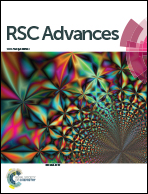Modified hydrothermal reaction (MHT) for CoV2O6·4H2O nanowire formation and the transformation to CoV2O6·2H2O single-crystals for antiferromagnetic ordering and spin-flop†
Abstract
A modified hydrothermal protocol (MHT) has been adopted for the synthesis of a single-crystal of CoV2O6·2H2O. The crystals grew as a result of prolonged hydrothermal reaction between precursor salts of CoCl2 and ammonium vanadate. At first, the adopted reaction conditions resulted in nanowires of CoV2O6·4H2O. Then with increased reaction time, nanowires changed to single crystals of molecular formula CoV2O6·2H2O. The nanowires have lengths of several tens of micrometers and average diameter of 100 nm. The well defined structure crystallizes in the orthorhombic crystal system having space group Pnma and it displays a = 5.5647(2) Å, b = 10.6870(5) Å, c = 11.8501(5) Å, α = β = γ = 90.00°. Here, each vanadium atom is tetrahedrally connected to four oxygens where two oxygens are connected to vanadium atoms and another two connected to cobalt atoms. Magnetic moment measurement of the nanowires indicates that antiferromagnetic ordering is observed at around 14.9 K and 6.8 K and field induced antiferromagnetic to ferromagnetic (spin-flop-type) transitions have been observed at a low temperature (5–8.8 K) range while these are absent in the as-synthesized single crystals.


 Please wait while we load your content...
Please wait while we load your content...